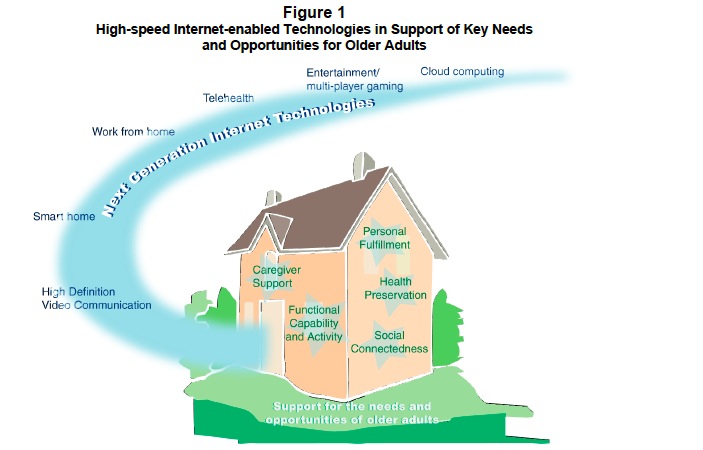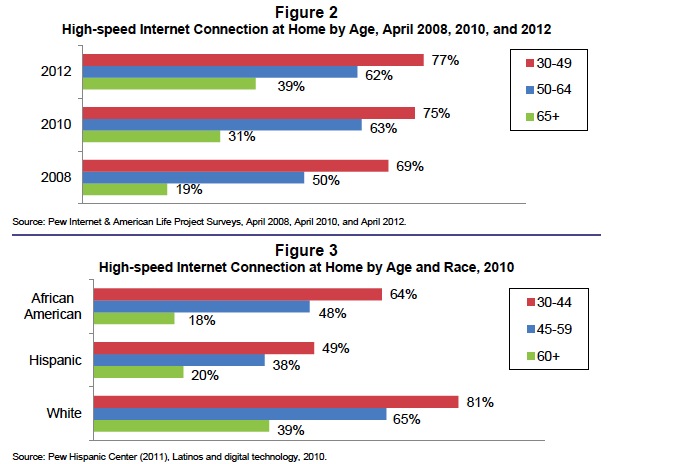AARP PUBLIC POLICY INSTITUTE
In an increasingly digital world, where a new generation of Internet-based services promises vast opportunities and benefits, many older adults do not have affordable, high-speed Internet connectivity at home. The Federal Communications Commission (FCC) highlighted the need to increase the use of high-speed Internet technologies among older Americans as part of the 2010 National Broadband Plan. Three years later, a review of the National Broadband Plan suggests slow and uncertain progress to address key barriers to broadband adoption and use among older adults.
High-speed Internet Connectivity Enables a New Generation of Services and Benefits
The experience of Internet connectivity has changed substantially since the mid- 1990s. For many Internet users, what was once predominantly a medium for sending email and reading Web pages has become a more powerful and common platform for accessing and sharing all types of interactive multimedia services. Much of this change is the result of technologies that have increased the capacity of users to transmit audio, video, and data across the Internet.
The capacity or bandwidth of an Internet connection, frequently referred to as “speed,” is a measure of how much information can move from one point to another in a given amount of time. In general, users with slow Internet connections are limited to basic applications. Higher-speed Internet service supports a greater flow of content, an easier and faster way to access information, and a better user experience. More important, high-speed connectivity enables a new generation of applications and services that have the potential to address a broad array of societal and individual needs.
Emerging Internet Technologies Promise to Empower Older Adults in Key Areas of Life
A variety of emerging Internet-based technologies have the potential to empower older adults to live more productive, independent, and satisfying lives. In fact, research suggests that technology can help support the needs and ambitions of older adults in five broad, interrelated impact areas: personal fulfillment, health preservation, social connectedness, functional capability and activity, and caregiver support (Figure 1).
Personal Fulfillment
A range of technologies and applications are available or emerging that can make it easier and more convenient for older adults to engage in meaningful and personally fulfilling activities. The impact of these
technologies can be particularly powerful in support of paid work, continuing education, and volunteering, as these activities enable older adults to make important contributions to society and enhance their own well-being. For example, the option of working from home can be particularly valuable to older adults who face growing demands to manage complex health, retirement, and care arrangements. In this regard, Internet-enabled videoconferencing and real-time document sharing can increase effectiveness and productivity when employees work from home or entrepreneurs operate a home-based business. Similar technologies can facilitate distance-learning opportunities and volunteer activities at convenient times and places, especially for individuals who have jobs, disabilities, or family responsibilities that make it difficult to travel to a classroom.
Health Preservation
Internet-enabled technologies create opportunities to help older adults take advantage of preventive health services, participate in physical activity, and self-manage chronic diseases that can help prevent or postpone functional decline. For example, the use of increasingly sophisticated home-based “smart medical services” supports the long-term treatment of chronic diseases. Online multiplayer gaming and virtual reality systems such as Nintendo Wii or Sony PlayStation can help promote physical activity and exercise among older adults.
The use of video conferencing and telepresence technology to connect patients to health professionals and services can help expand access to primary and preventive care and improve patient outcomes. In fact, a recently released large-scale study of patients receiving mental health services showed that providing these services through remote high-speed video conferencing can dramatically reduce hospital admissions and total hospitalized days.
Download full report (PDF): A Connection for All Ages
About the AARP Public Policy Institute
www.aarp.org/research/ppi
“The Public Policy Institute (PPI) is the focal point of public policy research, analysis and development at AARP. Led by AARP Senior Vice President Susan Reinhard, PPI’s staff works to design policies that have a significant impact on improving economic security, health care and quality of life. Founded in 1985, PPI publishes staff research and analysis regularly throughout the year. Publications from 1998 to the present can be found on this site.”
Tags: AARP, AARP Public Policy Institute, Elderly, Highspeed internet, Internet








 RSS Feed
RSS Feed